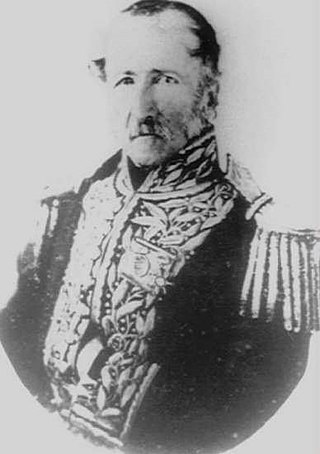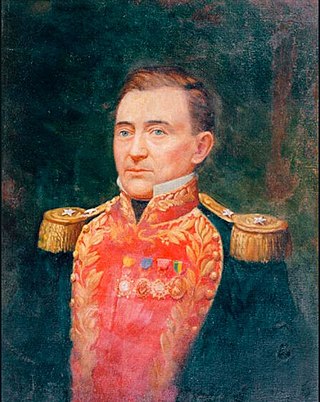
The third USS Hornet was a brig-rigged sloop-of-war in the United States Navy. During the War of 1812, she was the first U.S. Navy ship to capture a British privateer.

HMS Liverpool was a Royal Navy Endymion-class frigate, reclassified as a fourth rate. She was built by Wigram, Wells and Green and launched at Woolwich on 21 February 1814. She was built of pitch-pine, which made for speedy construction at the expense of durability.

Vice-Admiral Sir Henry Hotham was officer of the British Royal Navy who served during the French Revolutionary, Napoleonic Wars, and the War of 1812, was later a member of the Board of Admiralty, and ended his career as Commander-in-Chief of the Mediterranean Fleet.

The British Legion or British Legions were foreign volunteer units which fought under Simón Bolívar against Spain for the independence of Colombia, Venezuela, and Ecuador, and under José de San Martín for the independence of Peru, in the Spanish American wars of independence. Venezuelans generally called them the Albion Legion. They were composed of over seven thousand volunteers, mainly Napoleonic War veterans from Great Britain and Ireland, as well as some German veterans and some locals recruited after arriving in South America. Volunteers in the British Legion were motivated by a combination of both genuine political conviction and mercenary motives.

Révolutionnaire, was a 40-gun Seine-class frigate of the French Navy, launched in May 1794. The British captured her in October 1794 and she went on to serve with the Royal Navy until she was broken up in 1822. During this service Revolutionnaire took part in numerous actions, including three for which the Admiralty would in 1847 award clasps to the Naval General Service Medal, and captured several privateers and merchant vessels.

HMS Cyane was a Royal Navy Banterer-class sixth-rate post ship of nominally 22 guns, built in 1806 at Topsham, near Exeter, England. She was ordered in January 1805 as HMS Columbine but renamed Cyane on 6 December of that year. Cyane had a distinguished career in British service that included the award in 1847 of a clasp to the Naval General Service Medal to any still surviving crew members of either of two actions. On 20 February 1815, she and HMS Levant engaged USS Constitution; outgunned, both had to surrender. She then served as USS Cyane, including a stint on anti-slavery duties, until she was broken up in 1836.

HMS Volage was a Laurel-class sixth-rate post-ship of the Royal Navy. She served during the Napoleonic War, capturing four privateers and participating in the Battle of Lissa (1811). She was sold in 1818. Her new owners renamed her Rochester and she served in a commercial capacity for another 12 years, first sailing between England and India, and then making two voyages to the South Seas as a whaler. She was last listed in Lloyd's List in 1831.

Joaquín París y Ricaurte was a Colombian military officer and politician who fought in the Colombian War of Independence and various civil wars that took place in Colombia during the 19th century. París was later also commander-in-chief of the army and Secretary of War on various occasions.
Eight ships of the Royal Navy have borne the name HMS Spey, after the River Spey, in Scotland:

HMS Cambrian was a Royal Navy 40-gun fifth-rate frigate. She was built and launched at Bursledon in 1797 and served in the English Channel, off North America, and in the Mediterranean. She was briefly flagship of both Admiral Mark Milbanke and Vice-Admiral Sir Andrew Mitchell during her career, and was present at the Battle of Navarino. Cambrian was wrecked off the coast of Grabusa in 1828.

HMS Espoir was a Cruizer-class brig-sloop of the Royal Navy, launched in 1804. She served during the Napoleonic Wars, primarily in the Mediterranean, and then briefly on the North American station. She was broken up in April 1821.

HMS Rover was a Royal Navy Cruizer-class brig-sloop laid down in 1804 but not launched until 1808. She served in the North Sea, off the north coast of Spain, in the Channel, and on the North American station. She captured two letters-of-marque and numerous merchant vessels before being laid-up in 1815. She then sat unused until she was sold in 1828. She became a whaler that made four voyages to the British southern whale fishery between 1830 and 1848. She was last listed in 1848.
HMS Foxhound was the French Navy's brig Basque, launched in 1809, that the British Royal Navy captured in 1809 and took into service as a 16-gun sloop. She had a relatively brief naval career in which she captured a number of merchant vessels. After the Navy sold her in 1816, she made some 10 or 11 whaling voyages between 1817 and 1848.
HMS Saracen was launched in 1812 at Portsmouth for the British Royal Navy. She had an active, though brief, naval career during which she captured a number of enemy-held islands and enemy vessels. The navy sold her in 1819 and new owners employed her as a whaler for two voyages between 1819 and 1826. She was apparently wrecked in 1828 off the coast of Chile, but with little or no loss of life.
HMS Challenger was a Cruizer-class brig-sloop launched at Redbridge, Southampton, in 1813. She participated in the capture of a French privateer and then sailed to the East Indies. She was laid up in 1819 and sold in 1824.

Thomas Charles Wright (1799–1868) was an Irish-born naval admiral. He was the founding-father of the Ecuadorian Navy, and a general in Simón Bolívar's army. He is regarded as a leading militarist in Ecuador's and other South American countries' struggle for independence.
Lady Boringdon, was launched at Great Yarmouth in 1804, possibly under another name. She does not appear in the registers until 1815. She then became an East Indiaman, sailing under a license from the British East India Company (EIC). In 1822 she was sold to the Colombian Government and became the naval brig Constitución; her ultimate fate is currently unknown.
Three vessels named Frederick have served the British Royal Navy (RN). In each case, the service was brief.
Charles Sotheby was an officer in the Royal Navy who served during the French Revolutionary and Napoleonic Wars, eventually rising to the rank of rear admiral. Sotheby was present as a midshipman at the Battle of the Nile in 1798, serving aboard the 74-gun HMS Alexander, and took part in the Siege of Malta and subsequent operations in Egypt in 1801. Sotheby was made acting lieutenant on the 36-gun frigate HMS Penelope in October 1801, an appointment that was confirmed in January the following year. He served in that capacity in the English Channel and North Sea. In April 1807, he joined HMS Thetis for service in the Anglo-Turkish War.
HMS Tyne was launched at Topsham in 1814 as a Conway-class sixth rate. She served in the East Indies and in the Pacific Squadron. She also served in the Caribbean, cruising against pirates, during which she captured the pirate schooner Zaragozana. In 1825 the Navy sold Tyne and she became the whaler William. She was lost in early 1827 in the Bonin Islands on her first voyage to the British southern whale fishery.













